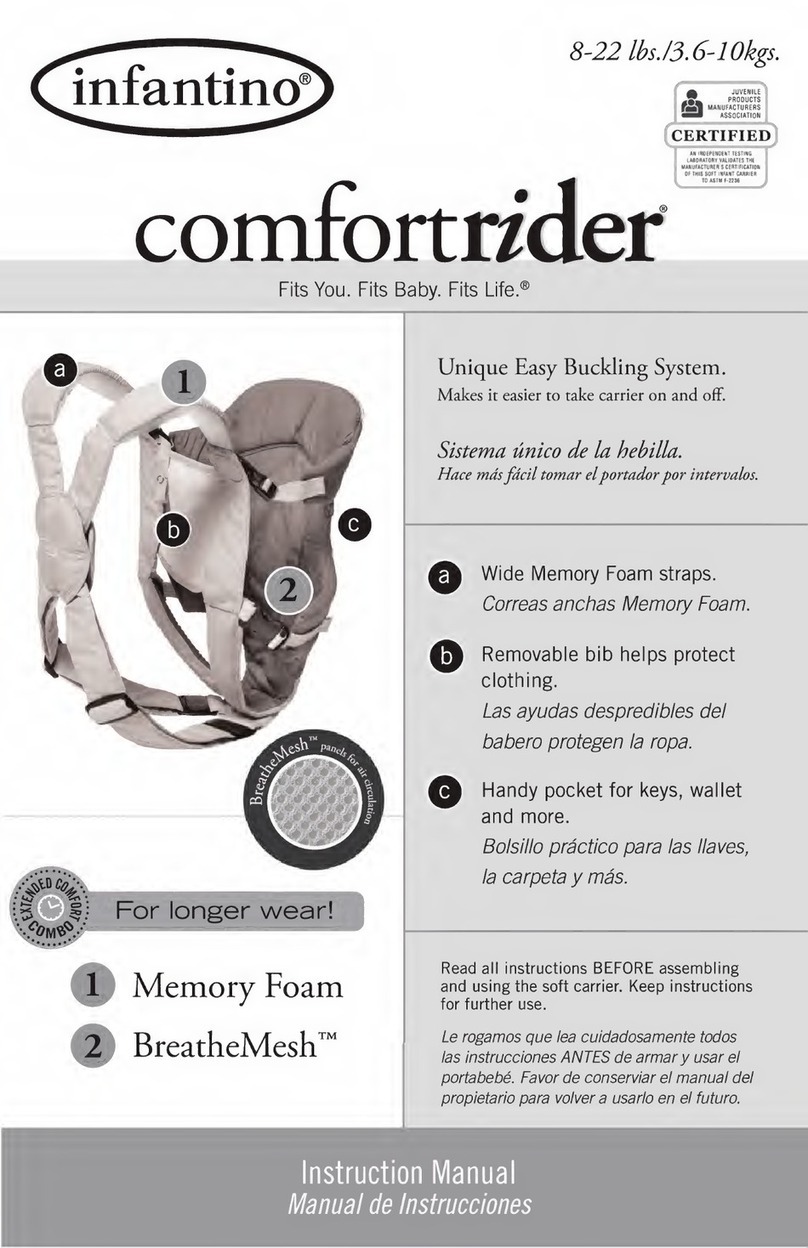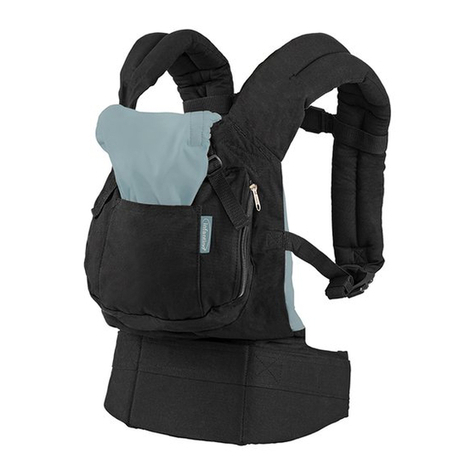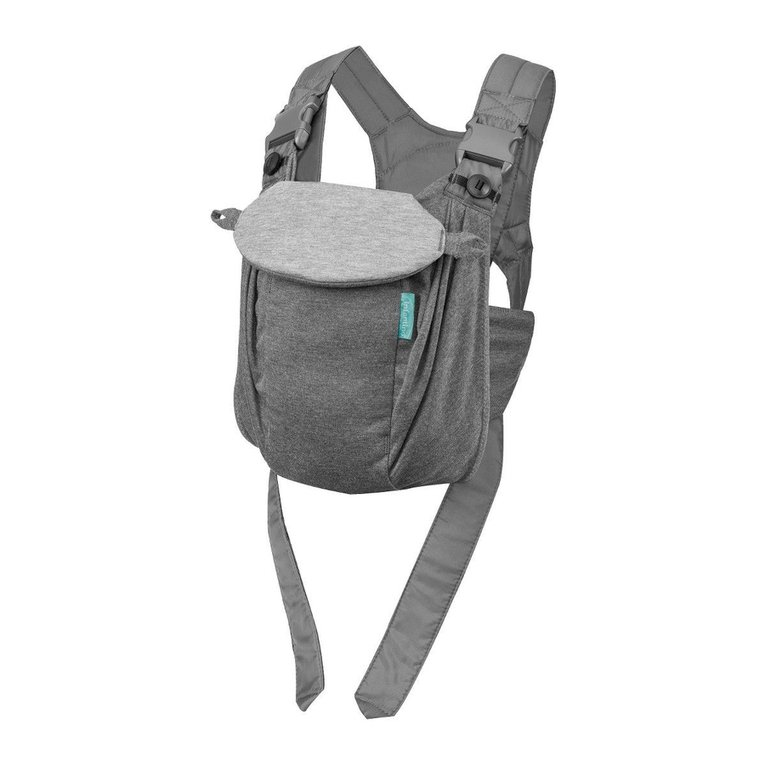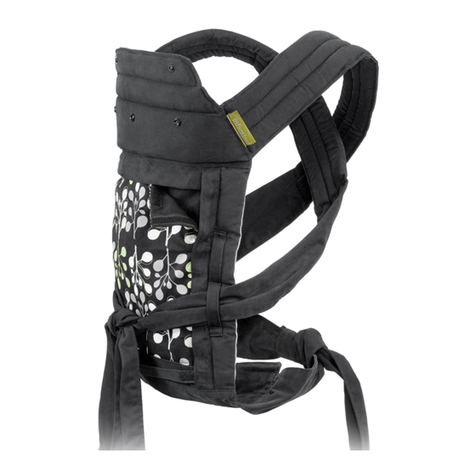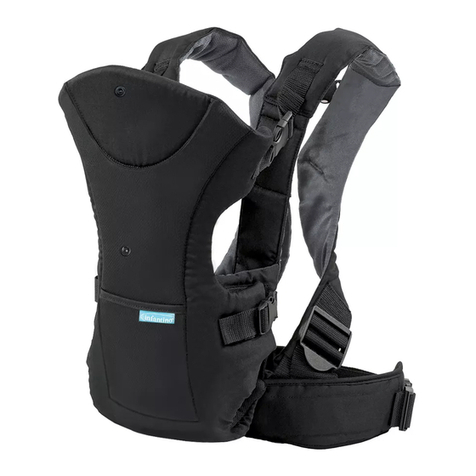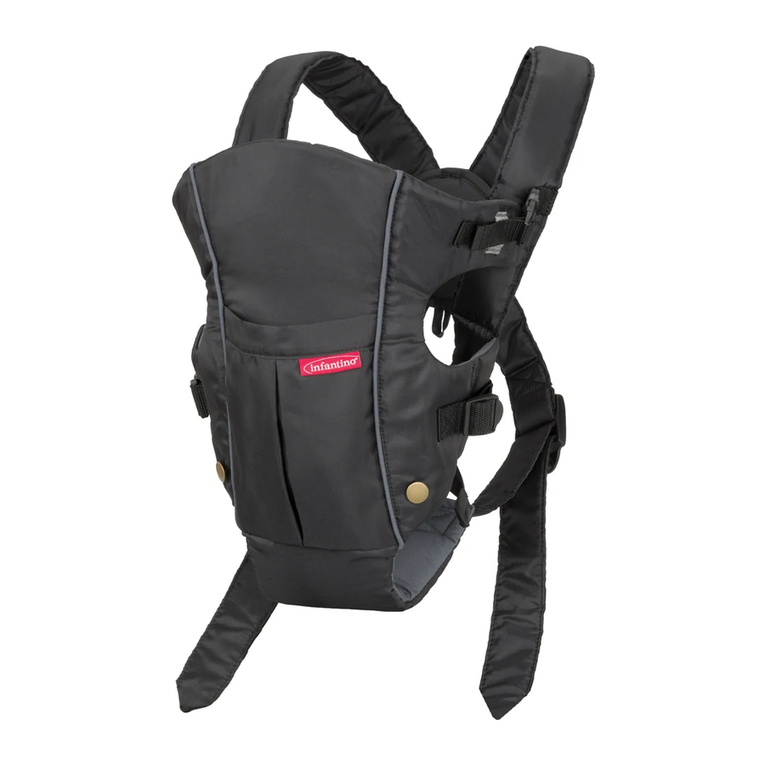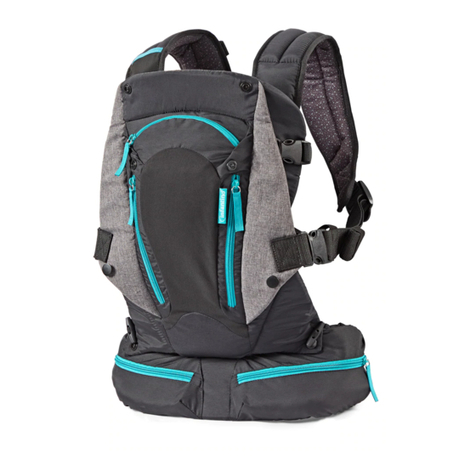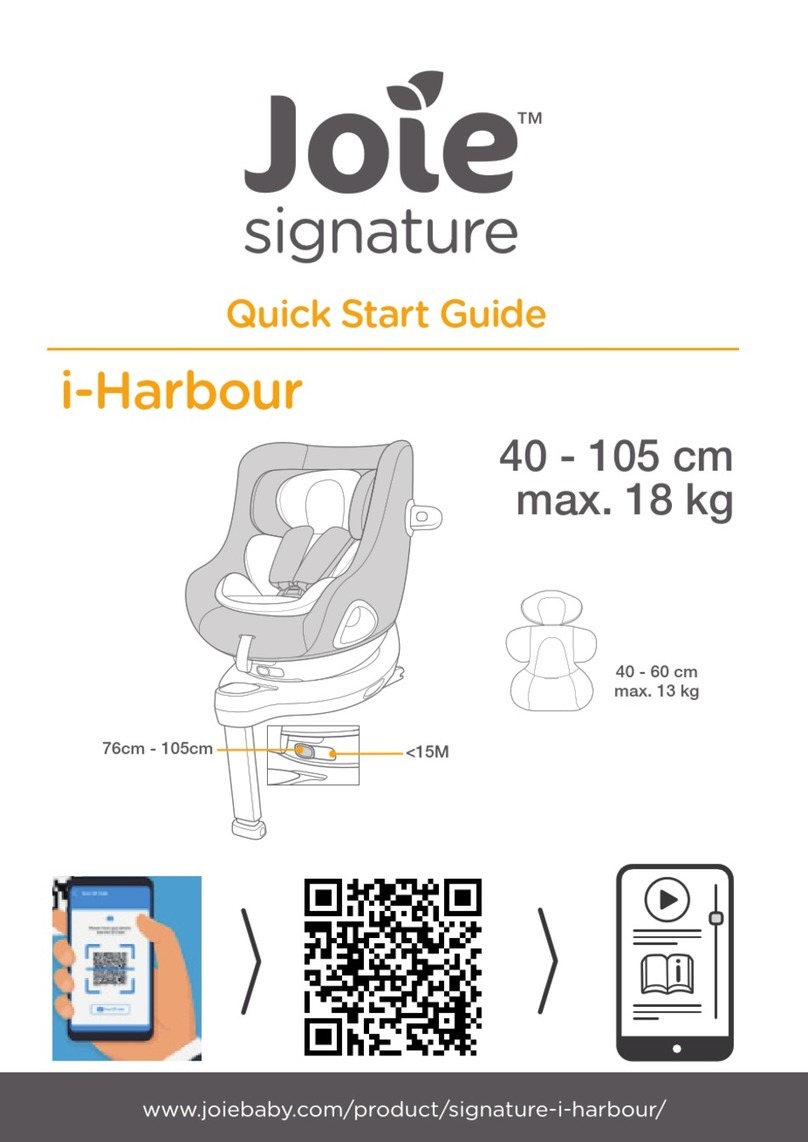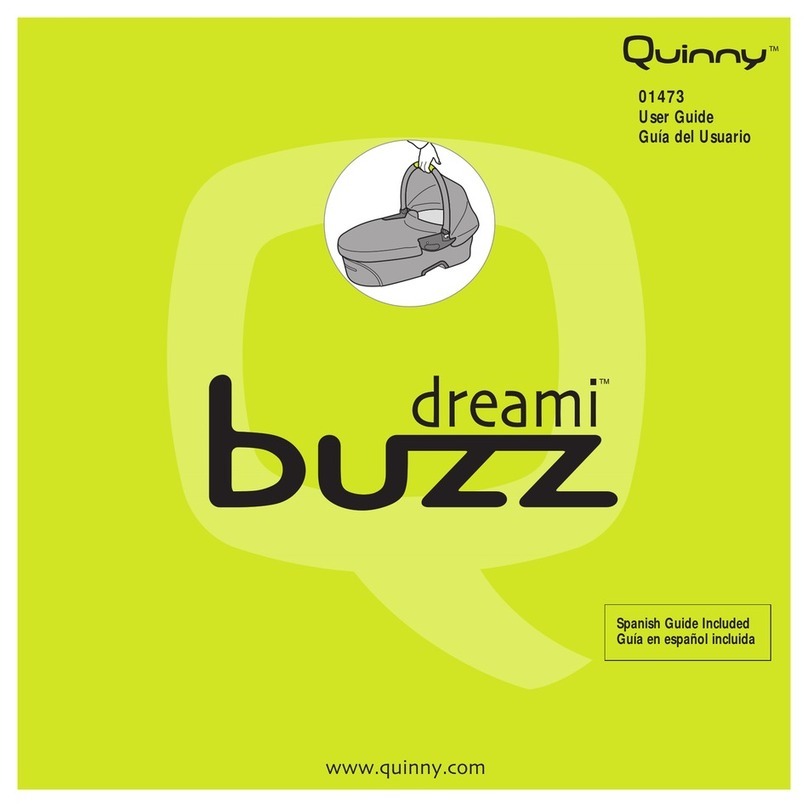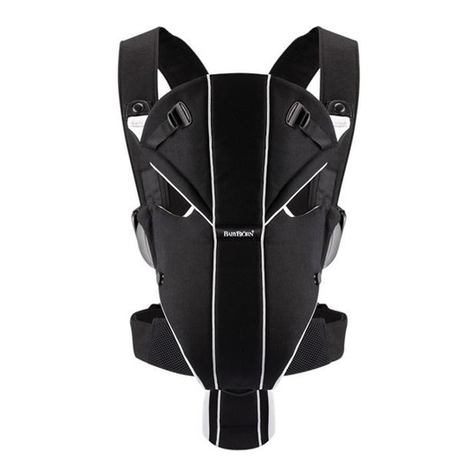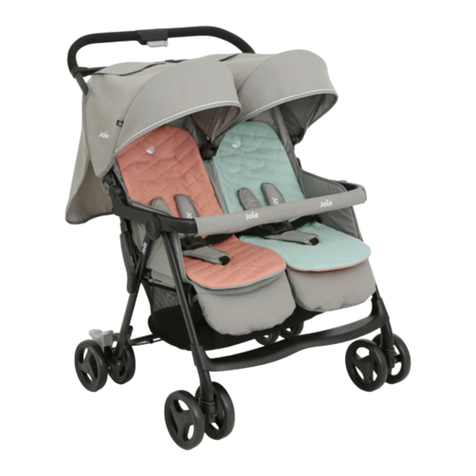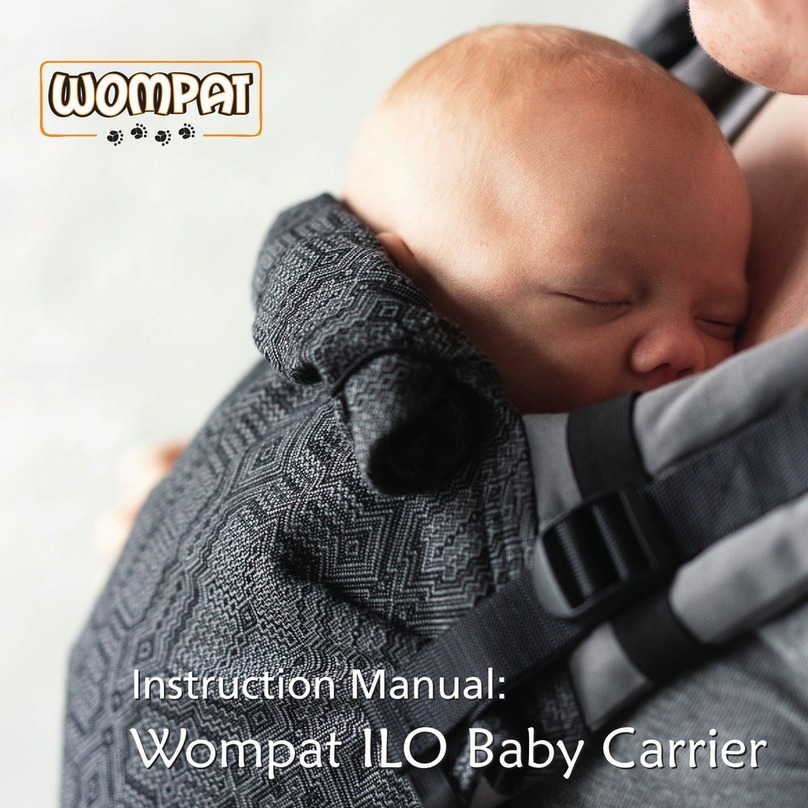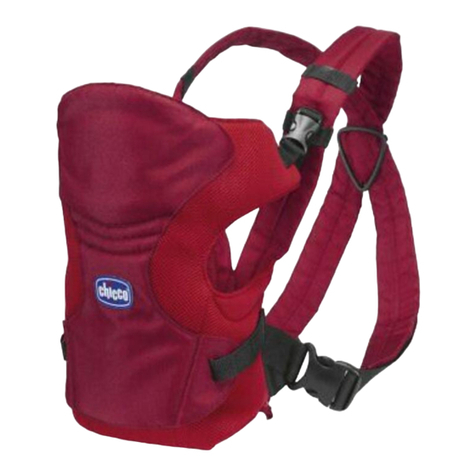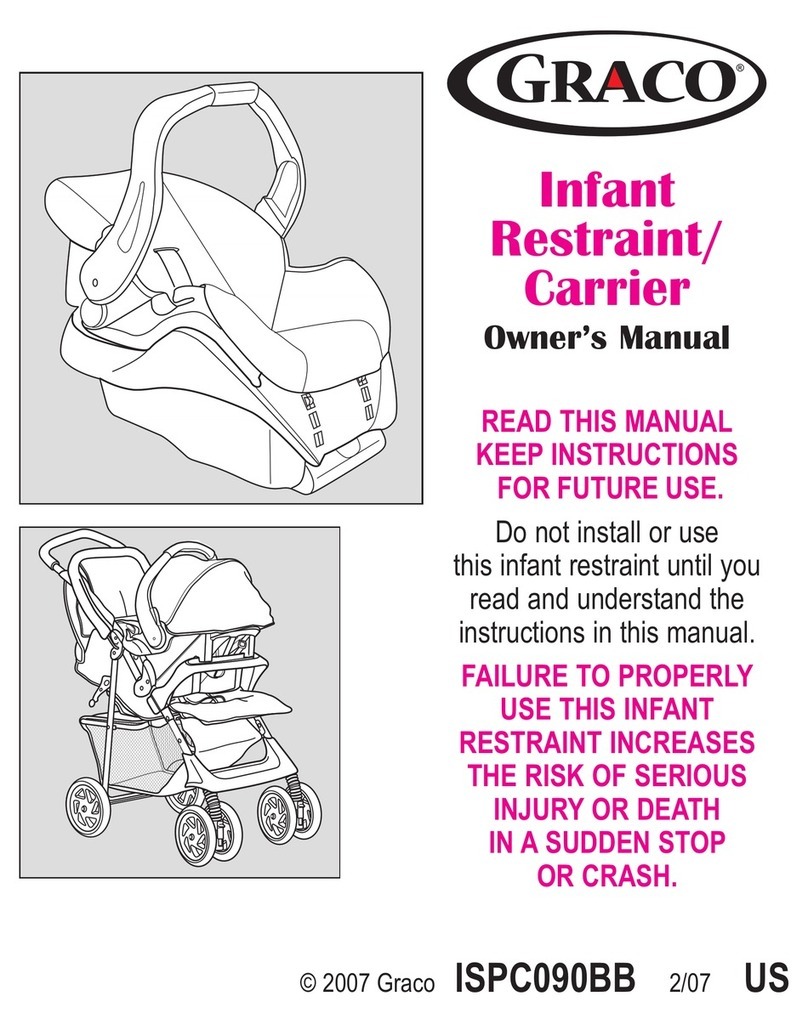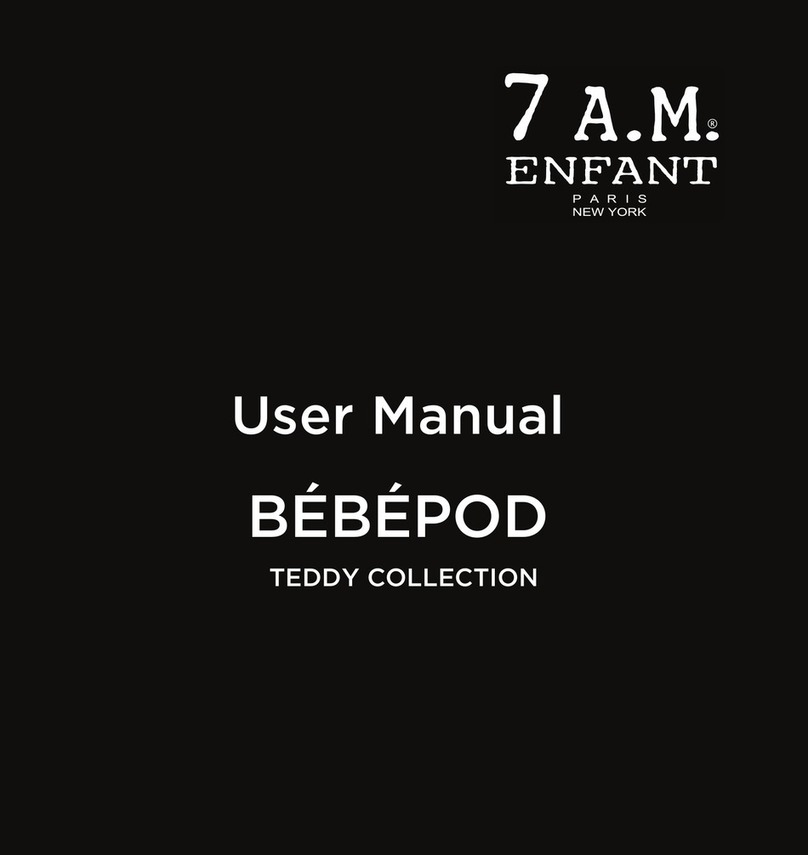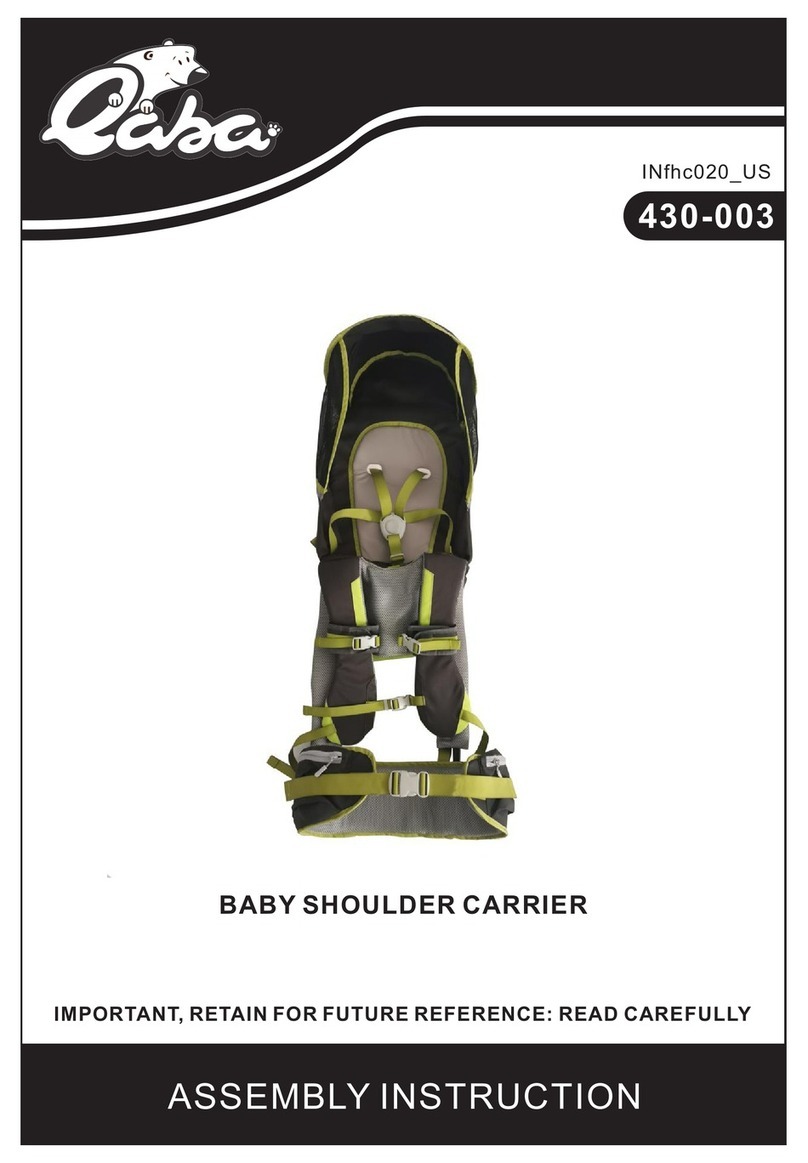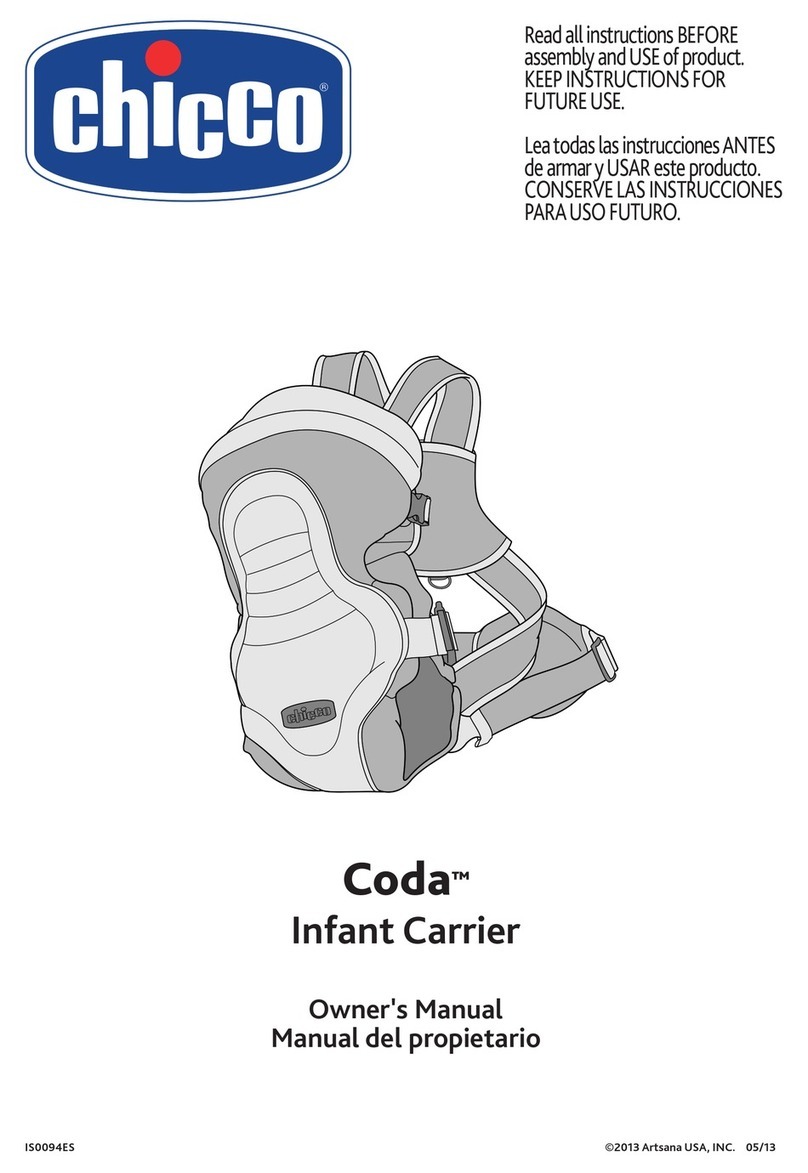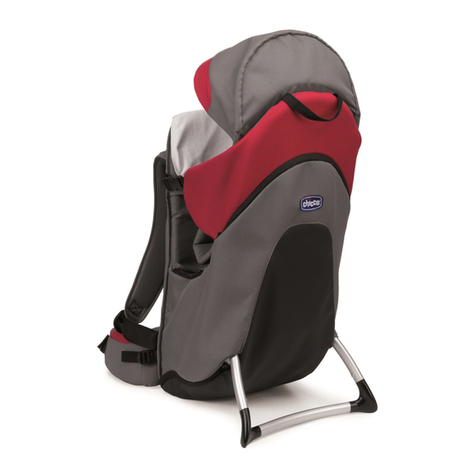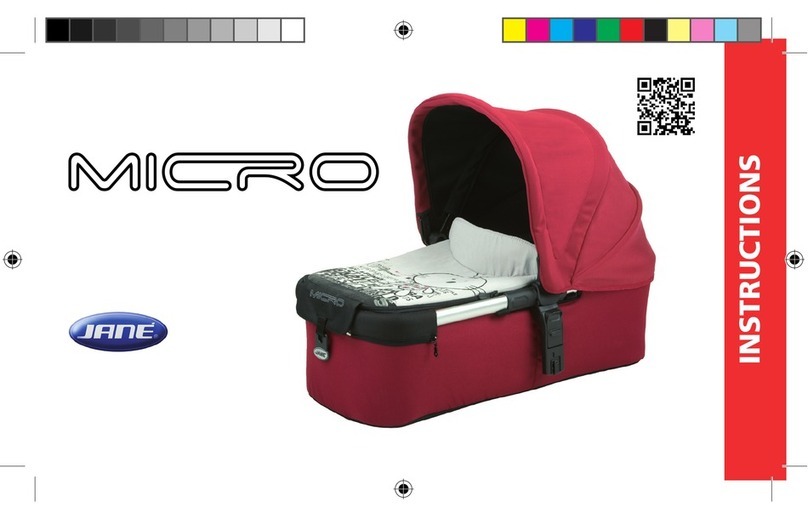
WARNING: FALL AND SUFFOCATION HAZARD
FALL HAZARD - Infants can fall through a wide leg opening or out of carrier.
• Adjust leg openings to fit baby’s legs snugly.
• Before each use, make sure all fasteners are secure.
• Take special care when leaning or walking.
• Never bend at waist; bend at knees.
• Only use this carrier for babies between 5.5 kgs (12 lbs) and 18 kgs (40 lbs).
SUFFOCATION HAZARD - Infants under 4 months can suffocate in this product if face is pressed
tight against your body.
• Do not strap infant too tight against your body.
• Allow room for head movement.
• Keep infant’s face free from obstructions at all times.
WARNING
• Follow instructions for use. When fastening the carrier, keep one hand on baby at all times.
• This carrier is NOT intended to be used for Baby Facing Out Position.
• Baby must be able to sit up on his or her own before being worn in the Back Carry Position to avoid possible back or neck
injury.
• Premature infants, infants with respiratory problems, and infants under 4 months are at greatest risk of suffocation.
• Baby's face should always be visible and free from obstructions.
• Be aware of your surroundings. Avoid any potential hazards or obstructions when putting baby in the carrier and when
removing baby from the carrier.
• NEVER use a soft carrier when balance or mobility is impaired because of exercise, sporting activities, drowsiness, or
medical conditions. It is intended for use by adults while walking or standing only.
• Your balance may be adversely affected by your movement and that of your baby.
• Never use a soft carrier while engaging in activities such as cooking and cleaning which involve a heat source or exposure
to chemicals. Keep away from fire and strong heat sources while wearing this carrier.
• Never wear a soft carrier while driving or being a passenger in a motor vehicle. DO NOT use this carrier as a child restraint
in a motor vehicle. This type of carrier will not properly restrain your baby in the event of a crash.
• NEVER leave baby unattended in this carrier.
• ALWAYS check to ensure that all buckles, snaps, straps, and adjustments are secure before each use. Make sure baby is
properly placed in the carrier, including leg placement, before each use.
• This product is subject to wear and tear over time. Check for ripped seams, torn straps or fabric and damaged fasteners
before each use.
• DO NOT use this product if deterioration or problems are detected.
• NEVER lean against baby.
• NEVER place more than one child in this carrier.
• DO NOT wear more than one carrier at a time, ever.
• DO NOT use in showers, pools, or any water environments.
WARNING: Constantly monitor your child and ensure the mouth and nose are unobstructed.
WARNING: For pre-term, low birthweight babies and children with medical conditions, seek advice from a health professional
before using this product.
WARNING: Ensure your child’s chin is not resting on its chest as its breathing may be restricted which could lead to suffocation.
WARNING: To prevent hazards from falling ensure that your child is securely positioned in the sling.
The carrier should be aware of the increased risk of your child falling out of the sling as it becomes more active.
Keep this sling away from children when it is not in use.
Awareness of hazards in the domestic environment e.g. heat sources, spilling of hot drinks. Only use the product for the number of
children for which the product is intended.
Take care when bending and leaning forwards or sideways.
Helpful Hints:
• The Zip™ Travel Carrier is designed for greater comfort for both you and your child. The strap system distributes baby’s
weight to make carrying more comfortable for you and baby, letting baby ride in a natural seated position.
• Front Carry Position - Until your child is able to fully sit upright on their own, this is the correct position. In this position,
you can entertain your baby and bond with them while still having your hands free.
• How do you know if your baby is at the right height when worn in the front? - You should be able to tilt forward slightly and
kiss the top of your child’s head.
• When placing your baby in or taking them out of the carrier, sitting down will make the process easier. Until you are
familiar with the placement of baby, it is also recommended to do so over a soft surface.
• It is best to limit the use of your carrier to 10-20 minutes until you and your baby are both completely comfortable in it
together.
• Back Carry Position - When your little one can fully sit up on their own, you also have the option of carrying them on your
back. This position allows your baby to have the best of both worlds - to be carried by you, but also be free to check out what
is going on around them.
AVERTISSEMENT: DANGER DE CHUTE ET DE SUFFOCATION
DANGER DE CHUTE - Les bébés peuvent tomber par l’ouverture de la jambe ou du porte-bébé.
• Ajustez les ouvertures de jambes pour qu’elles soient bien ajustées à la jambe du bébé.
• Avant chaque utilisation, assurez-vous que chaque attache est solide.
• Faites bien attention lorsque vous vous penchez ou marchez.
• Ne vous pliez jamais à la taille, toujours aux genoux.
• N’utilisez ce porte-bébé que pour les bébés entre 5,5 kg (12 lb) et 18 kg (40 lb).
DANGER DE SUFFOCATION - Les enfants de moins de 4 mois peuvent suffoquer dans ce
porte-bébé si leur visage est trop près de votre corps pour respirer.
• N’attachez pas le bébé trop serré contre votre corps.
• Laissez assez d’espace pour que la tête puisse bouger.
• La tête du bébé ne doit jamais être obstruée.
AVERTISSEMENT
• Suivez les instructions d'utilisation. Lorsque vous attachez le porte-bébé, gardez toujours une main sur le bébé.
• Ce porte-bébé n'est PAS conçu pour positionner le bébé vers l'extérieur.
• Le bébé doit pouvoir s'asseoir seul avant d'être porté dans la position dorsale pour éviter d'éventuelles blessures au dos ou
au cou.
• Les enfants prématurés, les nourrissons souffrant de problèmes respiratoires et les nourrissons de moins de 4 mois
courent le plus grand risque d'étouffement.
• Le visage du bébé doit toujours être visible et exempt d'obstructions.
• Soyez conscient(e) de votre environnement. Évitez tout danger ou obstruction possible lorsque vous placez le bébé et
lorsque vous retirez le bébé du porte-bébé.
• N'utilisez JAMAIS un porte-bébé souple lorsque votre équilibre ou votre mobilité est altéré en raison d'exercices,
d'activités sportives, de somnolence ou de problèmes médicaux. Il est destiné à être utilisé seulement par un adulte qui
marche ou qui se tient debout.
• L'équilibre de la personne peut être affecté par tout mouvement qu'elle et l'enfant peuvent faire.
• N'utilisez jamais un porte-bébé souple lorsque vous réalisez des activités telles que la cuisine et le nettoyage qui
impliquent une source de chaleur ou une exposition à des produits chimiques. Restez éloigné(e) du feu et des sources de
chaleur lorsque vous utilisez ce porte-bébé.
• N'utilisez jamais un porte-bébé souple lorsque vous conduisez ou en tant que passager dans un véhicule automobile.
N'utilisez PAS ce porte-bébé comme dispositif de retenue pour les enfants dans un véhicule automobile. Ce type de
porte-bébé ne protègera pas correctement votre bébé en cas d'accident.
• NE laissez JAMAIS le bébé sans surveillance dans ce porte-bébé.
• Vérifiez TOUJOURS que toutes les boucles, les boutons-pressions, les sangles et les réglages sont bien sécurisés avant
chaque utilisation. Assurez-vous que le bébé est correctement placé dans le porte-bébé, y compris le positionnement de
ses jambes, avant chaque utilisation.
• Ce produit est sujet à l'usure avec le temps. Vérifiez si des coutures ne sont pas déchirées, si les sangles ne sont pas
abimées ou si le tissu et les attaches ne sont pas endommagés avant chaque utilisation.
• N'utilisez PAS ce produit en cas de détérioration ou si des problèmes sont détectés.
• NE vous penchez JAMAIS contre le bébé.
• NE placez JAMAIS plus d'un bébé dans ce support.
• NE portez PAS plus d'un porte-bébé à la fois.
• N'utilisez PAS ce produit dans une douche, dans une piscine ou dans tout autre milieu aquatique.
ATTENTION: Surveillez constamment votre enfant et veillez à que sa bouche et son nez sont .
ATTENTION: Pour les bébés nés avant terme, de faible poids à la naissance et les enfants sous conditions médicales, il est
fortement recommandé de demander conseil à un professionnel de la santé avant d'utiliser ce pro.
ATTENTION: Assurez-vous que le menton de votre enfant ne repose pas sur sa poitrine car sa respiration pourrait être
restreinte, ce qui pourrait conduire à une asphyxie.
ATTENTION: Pour éviter tout risque de chute, assurez-vous que votre enfant est positionné en toute sécurité dans le
porte-bébé.
Soyez conscient du risque accru d'une chute de l'enfant lorsque celui-ci devient plus actif.
Gardez ce porte-bébé éloigné des enfants lorsqu'il n'est pas utilisé.
Soyez conscient des dangers de l’environnement domestique, par exemple les sources de chaleur, les projections de
liquides chauds. Utilisez le produit exclusivement pour le nombre d’enfants pour lequel il a été conçu.
Faites attention lorsque vous vous penchez en avant ou sur le côté.
Astuces utiles:
• Le porte-bébé de voyage Zip™ est conçu pour un plus grand confort pour vous et votre enfant. Le système des sangles
• Wearing the carrier closer to your body and higher up on your back (or chest when worn in the front position) will minimize
stress to your back and shoulders from prolonged use.
Care Instructions:
Machine wash cold, separately, on gentle cycle with mild detergent. DO NOT bleach. Wipe clean with cloth or sponge
between machine washings. Drip dry. DO NOT iron. Do not dry clean.
3.
